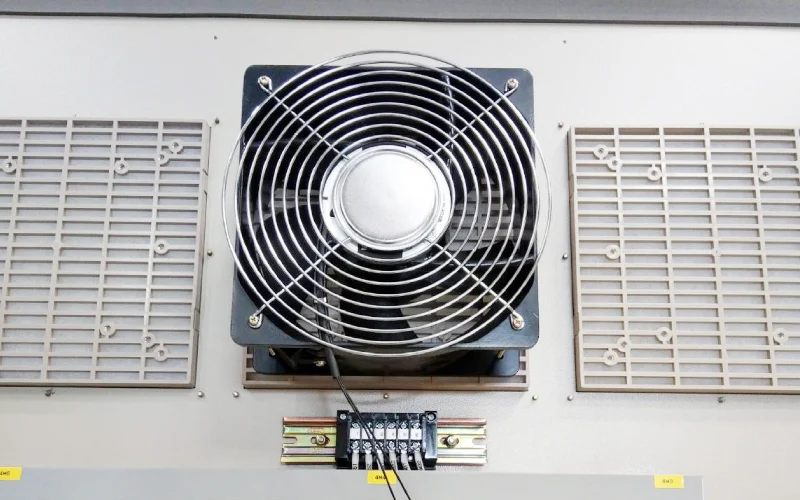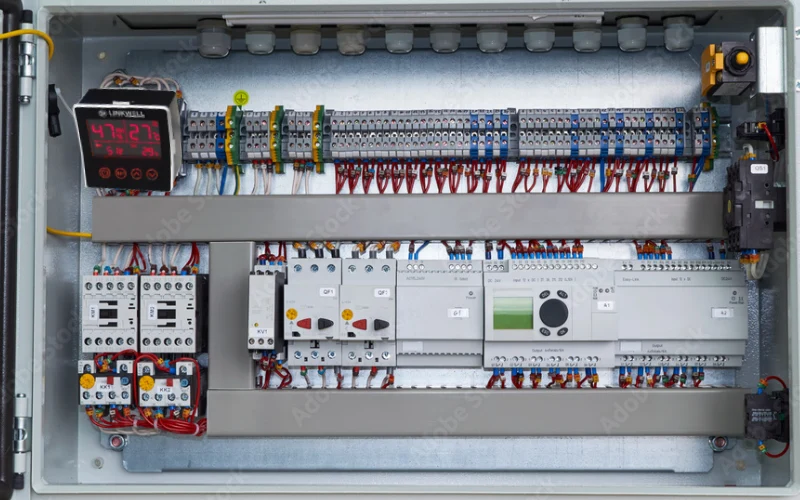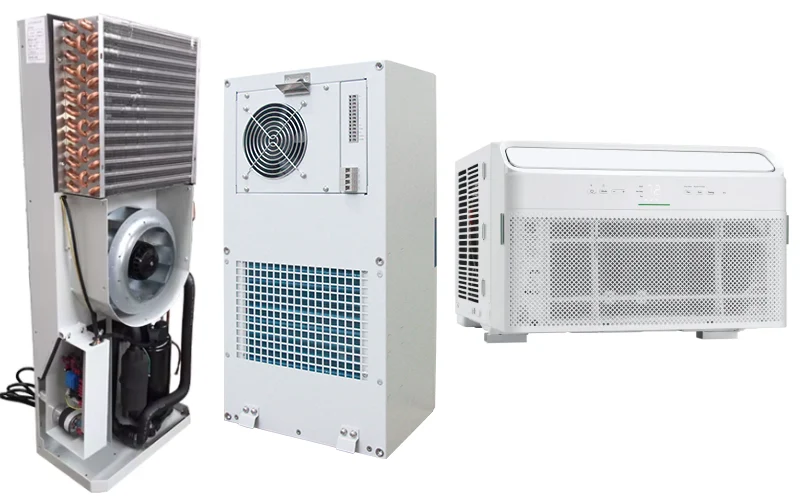If you’ve ever wondered what is electrical enclosure fan, you’re not alone. An electrical enclosure fan moves air inside cabinets, helping you control temperature and protect sensitive electronics. When the air gets too hot or humid, your equipment can overheat, corrode, or even shut down. Here’s why temperature control matters:
- Keeping air flowing prevents overheating and reduces thermal stress, which keeps your equipment working longer.
- Air circulation stops pockets of heat from forming, so components stay reliable.
- Managing air and humidity means fewer breakdowns and lower costs for repairs.
You can trust Linkwell to deliver high-quality enclosure fan solutions that keep your cabinets cool and your projects running smoothly.
Key Takeaways
- Electrical enclosure fans keep your equipment cool by moving air inside cabinets, preventing overheating and damage.
- Good airflow stops heat buildup and moisture, which helps your electronics last longer and work better.
- Choosing the right fan size and type ensures effective cooling and protects your devices from failure.
- Linkwell fans offer energy-efficient, easy-to-install solutions with strong protection against dust, moisture, and harsh conditions.
- Regular cleaning and maintenance of fans and filters save money by reducing repairs and downtime.
What is Electrical Enclosure Fan
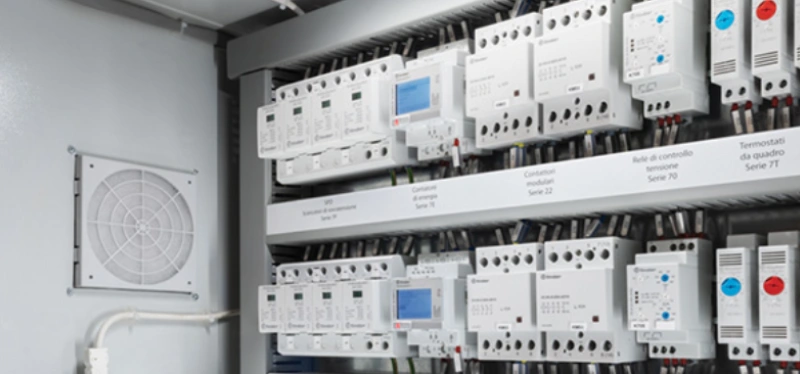
Definition and Purpose
You might ask yourself, what is electrical enclosure fan and why does it matter for your equipment? In the electrical engineering world, an electrical enclosure fan is a device that helps cool down cabinets, control panels, and even motor enclosures. You’ll find these fans mounted inside or outside the enclosure, moving air across sensitive electronics and cooling fins. The main job of an electrical enclosure fan is to push cooler air in and force hot air out, keeping the temperature inside safe for your devices.
When you use an enclosure fan, you protect your equipment from overheating, corrosion, and sudden shutdowns. These fans regulate temperature by improving airflow and dissipating heat. You get a safer environment for your electronics, which means fewer breakdowns and longer life for your gear. Different types of fans—like axial, centrifugal, and blowers—handle specific cooling needs. Some fans work best for large surfaces, while others focus on tight spaces or direct airflow to certain components.
Did you know? Linkwell stands out as a global leader in enclosure fan solutions. The company designs fans that are easy to install, energy-efficient, and built for tough environments. You get reliable cooling with features like weatherproof housing, modular components, and advanced safety protections.
Key Components
Let’s break down what makes an electrical enclosure fan work so well. You’ll see several important parts inside every fan, each playing a key role in performance:
- Impeller: This is the spinning part with blades. It creates airflow and helps move air through the enclosure.
- Motor: The motor powers the impeller. You can choose from AC, DC, or EC motors, depending on your energy needs and speed control.
- Shaft and Bearings: These keep the impeller spinning smoothly. Good bearings mean less noise and longer fan life.
- Fan Frame (Housing): The frame holds everything together and directs airflow. It also helps reduce noise.
- Fan Accessories: Guards and filters protect the fan and keep dust out. Filters are easy to replace and help maintain clean airflow.
Linkwell’s enclosure fans offer even more. You get a super flat blade design for quiet operation and optimal airflow. The fans come with IP54-rated housing, so dust and splashes won’t slow you down. Safety features protect against reverse polarity, short circuits, and over-voltage. You can reverse the fan for either air draft or air blow, giving you flexibility for any setup. Modular parts let you swap motors or blades to match your cooling needs. The ventilation shutters use flame-retardant ABS material for extra safety.
Here’s a quick look at the main fan types you might find:
| Fan Type | Best Use Case | Airflow Pattern |
|---|---|---|
| Axial Fan | General cooling, large areas | One direction |
| Centrifugal Fan | Confined spaces, high pressure | Outward from center |
| Blower | Focused airflow, low pressure | Directed stream |
| Cross Flow Fan | Wide, uniform cooling | Across length |
When you choose a Linkwell enclosure fan, you get a product designed for easy installation, strong protection, and long-lasting performance. You can trust these fans to keep your electrical cabinets cool and your equipment safe.
How Electrical Enclosure Fans Work
Airflow and Heat Dissipation
When you install an electrical enclosure fan, you create a steady path for air to move through your cabinet. The fan pulls cooler air from outside and pushes hot air out. This constant air flow keeps the temperature inside your enclosure stable. You don’t want heat to build up around your sensitive electronics. That’s where air flow and cooling come in.
The process starts with the fan’s impeller spinning and creating air movement. As air flows across your components, it picks up heat and carries it away. This is called forced air cooling. It’s much more effective than letting heat escape on its own. You get a steady stream of air that removes hot spots and keeps everything at a safe temperature.
To figure out how much air flow you need, you can use a simple formula. Take the heat load in BTU/hr and divide it by 1.95 times the temperature rise you’ll allow (in Celsius). Most people use a 10°C rise as a safe limit. For extra safety, you should pick a fan with a free-airflow rate at least three times higher than your calculation. This way, you make sure your enclosure always gets enough air flow, even if filters get dirty or the environment changes.
Tip: Always check the static pressure rating of your fan. If your enclosure has filters or tight spaces, static pressure can slow down air flow. You want a fan that can handle both maximum air flow and high static pressure for the best cooling.
Linkwell enclosure fans give you strong air flow and reliable cooling. Their fans use energy-efficient motors and optimized blades, so you get more air flow with less power. The weatherproof housing keeps dust and water out, so your fan keeps working even in tough conditions. You can also connect a thermostat to your fan. When the temperature inside your cabinet gets too high, the fan turns on automatically. When things cool down, it shuts off to save energy.
Protection for Electrical Components
You rely on your electrical enclosure fan to protect your most valuable equipment. Without proper air flow, heat can damage PLCs, VFDs, power supplies, inverters, and high-performance processors. These parts generate a lot of heat and need steady air flow to stay cool. If you don’t have enough air flow, you risk slowdowns, shutdowns, or even permanent damage.
Here’s how a good enclosure fan keeps your equipment safe:
- It uses forced air convection to move hot air out and bring cool air in.
- It creates clear air flow paths, so every part of your cabinet gets fresh air.
- It keeps static pressure low, so air can move freely even with filters or tight spaces.
- It prevents heat buildup, which lowers the risk of electrical fires and equipment failure.
You also get extra protection from Linkwell’s design features. The weatherproof housing blocks moisture, dust, and corrosion. This means your fan and your equipment last longer, even outdoors or in harsh environments. The thermostat integration makes sure your fan only runs when needed, keeping your cabinet at the right temperature without wasting energy.
Note: Good air flow and cooling can prevent over 70% of equipment failures. You can extend the life of your electronics by up to 40% just by keeping things cool and dry.
Energy-efficient enclosure fans help you save money, too. They use less power, which lowers your operating costs. Some fans even support solar power or demand-controlled ventilation, so you only use as much air flow as you need. This reduces your carbon footprint and helps your business stay green.
When you choose a Linkwell enclosure fan, you get a complete solution for air flow, cooling, and static pressure control. You protect your equipment, lower your costs, and keep your projects running smoothly.
Why You Need an Enclosure Fan
Preventing Overheating
You know how fast heat can build up inside an electrical cabinet. Without proper air flow, your equipment faces risks from loose connections, moisture, dust, and even high ambient temperatures. Modern panels pack more features into smaller spaces, which means higher thermal load and more heat. When you add external heat sources like sunlight or nearby machinery, the temperature inside can spike quickly.
Enclosure fans give you active cooling by moving air through the cabinet. This air flow pushes hot air out and brings cooler air in, keeping the temperature stable. Passive cooling just lets air move naturally, but it can’t handle high thermal load or sudden temperature changes. With a fan, you get precise control over air flow, so your equipment stays safe even in tough conditions.
Tip: Using a fan can make cooling five to ten times more efficient than relying on passive methods. You get better heat transfer and fewer hot spots.
Extending Equipment Life
When you keep air moving, you protect sensitive electronics from overheating and corrosion. Moisture and contaminants can sneak into enclosures, causing shorts and damage. Fans with multi-layer filtration block dust and moisture, keeping air clean and components safe. Consistent air flow helps maintain the right temperature, which means your equipment lasts longer and works better.
Linkwell enclosure fans come with certifications like UL, CE, and NEMA. These marks show you’re getting reliable and safe cooling solutions. The fans use durable materials and advanced sealing, so they stand up to harsh environments. You can trust them to keep your gear running for years.
Reducing Maintenance Costs
Nobody likes surprise repairs or downtime. When you use an enclosure fan, you cut down on maintenance by preventing overheating and keeping air flow steady. Fans with ball bearing motors and easy-to-clean filters make upkeep simple. You just inspect and clean the filters—no special tools needed.
Here’s how fans help you save money:
- They block dust and moisture, so you avoid costly repairs.
- Energy-efficient designs lower your power bills.
- You don’t need expensive air conditioning units for cooling.
- Predictable maintenance means less downtime and fewer headaches.
Linkwell fans are tested by independent labs and built to last. You get peace of mind knowing your cooling system is reliable and your maintenance costs stay low.
Applications of Linkwell Enclosure Fans
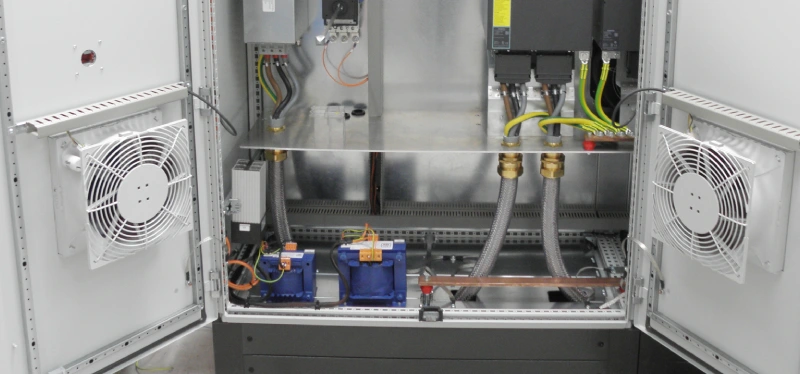
Industrial and Telecom Use
You see Linkwell enclosure fans in action across many industries. These fans handle tough jobs where air flow and static pressure matter most. In each application, you need steady air movement to keep equipment safe. Here’s a quick look at where you might use these fans:
| Industrial Sector | Key Equipment/Application Examples |
|---|---|
| Communication Infrastructure | 5G base stations, data center cabinets, edge computing nodes |
| New Energy Industry | Photovoltaic inverters, charging piles, energy storage batteries |
| Medical & Laboratories | Medical imaging equipment, lab precision instruments, cleanrooms |
| Industrial Automation | PLC control systems, industrial robot servo systems, inverters |
In telecom, you want reliable air flow to keep your systems running. Enclosure fans move air inside cabinets, which helps with heat dissipation and keeps static pressure balanced. You get better performance and longer life from your equipment. Here’s how these fans boost efficiency in telecom:
- Fans circulate air, so heat leaves the enclosure fast.
- Good air flow stops thermal buildup and keeps static pressure low.
- You can use these fans for both indoor and outdoor application needs.
- Fan cooling costs less than other cooling systems.
- Placing fans in the right spot and cleaning them often gives you the best air flow.
- Different fan types help you match air flow and static pressure to your application.
- Stable air flow means less downtime and fewer repairs.
You notice that air flow and static pressure work together. If you have high static pressure, you need a fan that can push air through filters and tight spaces. Linkwell fans give you that power, so your telecom cabinets stay cool and safe.
Control Cabinets and Signal Boxes
You use Linkwell enclosure fans in control cabinets and signal boxes every day. These spaces get hot fast, especially when you pack in lots of electronics. Air flow becomes your best friend here. You want air moving over every part, so nothing overheats. Static pressure can build up if you have filters or small vents, but the right fan keeps air moving strong.
In control cabinets, you protect PLCs, relays, and drives. Air flow helps you avoid hot spots and keeps static pressure from blocking air. You get steady cooling, which means your equipment lasts longer. In signal boxes, you need air to move past sensitive circuits. Fans keep static pressure low, so air reaches every corner.
You can trust Linkwell fans for any application where air flow and static pressure matter. The fans fit standard cutouts, so you install them fast. You get options for different air flow rates and static pressure levels. This means you always find the right fan for your application.
Tip: Always check your cabinet’s air flow needs and static pressure before picking a fan. The right choice gives you the best cooling and protects your investment.
Choosing the Right Electrical Enclosure Fan
Sizing and Environment
Picking the right electrical enclosure fan starts with understanding your cabinet’s needs. You want to make sure the fan delivers enough air flow to keep your equipment cool and safe. Start by checking the heat load inside your enclosure. Add up the wattage of all heat-producing components. This helps you figure out how much air you need to move.
Here’s a simple checklist to guide you:
- Calculate the required air flow. Use the heat load and desired temperature rise to find the airflow rating in CFM.
- Look at the type of air movement. Some fans push air in one direction, while others spread air across the enclosure.
- Check the space inside your cabinet. Make sure the fan fits without blocking air flow.
- Match the fan’s voltage and power draw to your supply.
- Choose a fan with a NEMA or IP rating that matches your environment. This protects against dust, moisture, and static pressure.
- Think about noise. If your cabinet sits in a quiet area, pick a fan with a low decibel rating.
- Make installation and maintenance easy. Fans with tool-less access and replaceable filters save you time.
If your environment has lots of dust or humidity, go for fans with high IP or NEMA ratings. These keep air moving while blocking contaminants. Regular cleaning and filter changes help maintain strong air flow and reduce static pressure.
Humidity and dust can cause problems inside your enclosure. High humidity may lead to condensation, risking equipment failure. Dust can clog vents and raise static pressure, making air flow less effective. You can use thermostatically controlled heaters and sealed enclosures to fight moisture. Filters and weatherproof housings help keep dust out and air moving smoothly.
Linkwell Product Options
Linkwell gives you plenty of choices for different enclosure sizes and environments. You can pick from models with various airflow ratings, noise levels, and protection features. Here’s a quick look at how Linkwell’s fans stack up:
| Feature | Base Model | Advanced Model | Pro Model |
|---|---|---|---|
| Airflow Capacity | 80 CFM | 92 CFM | 104 CFM |
| Noise Level | 65 dB | 58.5 dB | 52 dB |
| Motor Power | 50W | 75W | 100W |
| Filtration Efficiency | HEPA H13 | HEPA H14 | HEPA H14 + Carbon Layer |

You can choose IP44 fans for indoor use or IP65 fans for outdoor and dusty areas. Linkwell’s Pro model offers the highest airflow rating, lowest noise, and best filtration. If you need maximum air flow and low static pressure, this model is a great fit for harsh environments. The modular design makes maintenance easy, and the energy-efficient motors help you save on power bills.
Tip: Always match your fan’s airflow rating and static pressure capability to your enclosure’s heat load and environmental challenges. Linkwell’s range covers everything from basic indoor cabinets to outdoor telecom boxes exposed to dust, moisture, and high static pressure.
Choosing the right electrical enclosure fan keeps your equipment safe and running smoothly. You get lower energy bills, less downtime, and longer-lasting electronics. Linkwell fans stand out for their easy installation, strong protection, and smart design. Customers love the fast filter swaps, cleaner cabinets, and reliable cooling—even in tough environments.
Take a moment to check your cabinet’s airflow and temperature. If you want peace of mind and top performance, Linkwell has a solution that fits your needs.
FAQ
How do I know which enclosure fan size fits my cabinet?
Check your cabinet’s dimensions and heat load. Look at the airflow rating (CFM) on the fan’s label. Pick a fan that matches or exceeds your cooling needs. If you’re unsure, Linkwell’s team can help you choose the right size.
Can I install a Linkwell enclosure fan myself?
Yes, you can! Most Linkwell fans come with clear instructions and fit standard cutouts. You only need basic tools. If you run into trouble, Linkwell’s support team is ready to help you out.
How often should I clean or replace the fan filter?
You should check the filter every month. If you see dust or dirt, clean or replace it. Clean filters keep airflow strong and protect your equipment. Dirty filters can block air and cause overheating.
What certifications do Linkwell enclosure fans have?
Linkwell fans carry certifications like CE, UL, and ISO 9001. These marks show you get safe, reliable, and high-quality products. You can trust them for industrial, telecom, and outdoor use.

